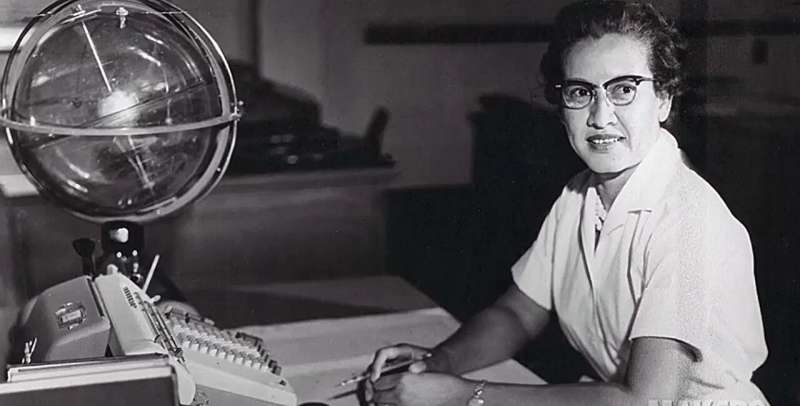This article has been reviewed according to Science X's editorial process and policies. Editors have highlighted the following attributes while ensuring the content's credibility:
fact-checked
trusted source
proofread
Study finds media coverage focused on NASA mathematician's achievements, but treated discrimination as past problem

Without Katherine Johnson, NASA would not have landed a man on the moon. The 2016 film "Hidden Figures" told Johnson's story as a brilliant mathematician, a trailblazer who overcame racism and sexism to succeed at NASA in the 1950s and '60s. That monumental career was again examined in the media following her death in 2020.
A new study from the University of Kansas analyzed news coverage of Johnson's death, finding that coverage focused on her achievements first but also tended to depict the race- and gender-based discrimination she faced as a problem of the past.
Steve Bien-Aimé, assistant professor of journalism & mass communications at KU, analyzed 42 news items and opinion pieces following Johnson's death to determine how her life and career were presented in newspapers.
"To be one of the premier mathematicians sending people to the moon means you are really good," Bien-Aimé said. "I wanted to know are they talking about that, or that she was a rarity as a Black female NASA mathematician, or that she was a pioneer? Overall, journalists did a pretty good job of presenting her as a brilliant mathematician first."
Coverage focused first on Johnson as a person. She was at the top of her field, and her expertise was vital to one of the foremost scientific achievements, it noted. Coverage mentioned that she overcame severe racial and gender discrimination.
However, newspapers tended to treat racism and sexism as though they were issues of the past, not problems still facing society today, according to the KU study. Coverage also did not examine why structural racism and sexism were and continue to be problems or who benefits from them.
"Katherine Johnson's time in science butted right up against Jim Crow and the civil rights era. Some of her most notable NASA work came about a decade after Brown v. Board, but it's not like a court decision made all discrimination go away," Bien-Aimé said. "There was not a name put on who did it or why such discrimination existed. When you avoid that, you also avoid examining how or why structural inequities are built and maintained."
Coverage of Johnson's death and career was good at using person-first language, or the fact that first and foremost, she was a brilliant mathematician. While it noted there was an underrepresentation of women in the sciences during her career, coverage also lacked citations of other women in discussing her work and legacy, the KU study found.
Fewer than half of the news items quoted women who were not Johnson, and many of those that did quote Margot Lee Shetterly, whose book was the basis for the film "Hidden Figures."
"The coverage showed she was great at what she did. If you say she was a great Black woman mathematician, you are putting qualifications on how good of a mathematician she was," Bien-Aimé said. "She was a brilliant mathematician, and those other identities are important, but we should treat her the same as others. She was noteworthy because they don't go to the moon without her."
The research, published in the Journal of Black Studies, notes that coverage of Johnson's death can serve as an example of hegemony, or reinforcing the status quo in that people can assume why the type of discrimination she faced existed.
However, that can amount to disavowal, or not addressing difficult topics because the writer or those in today's society feel they did not cause the issue, Bien-Aimé said. It also presented a missed opportunity to discuss issues such as disparities of women and people of color in STEM fields today.
Such presentations of notable figures are important not only for how they discuss one person and their experiences but for what they can tell us about current society and journalism, according to Bien-Aimé. He also said that how journalists portray individuals such as Johnson is important because of the shrinking media landscape and how their voices are amplified, whether their coverage is positive, negative, or ambivalent.
"Journalists have a tough job, and having to produce more and more content all the time, it is hard to produce more robust stories," Bien-Aimé said. "But we have to know if we are able to look at these situations and ask, 'Why is it rare? What makes this a novel event?'"
More information: Steve Bien-Aimé, "Hidden" No More: Newspapers' Framing of NASA Mathematician Katherine Johnson, Journal of Black Studies (2024). DOI: 10.1177/00219347231225746
Provided by University of Kansas





















